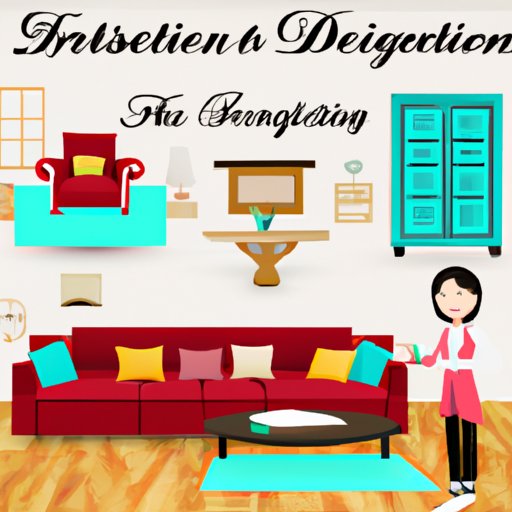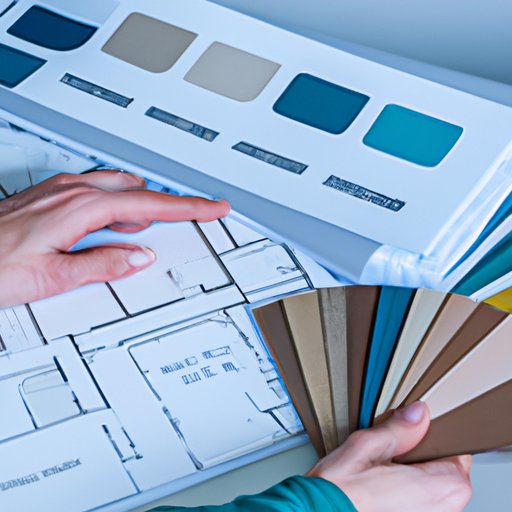Introduction
Interior designers are highly trained professionals who specialize in creating aesthetically pleasing and functionally efficient spaces. They combine their knowledge of architecture, building codes, and materials with their understanding of color theory, design principles, and furnishings to create unique living and working environments. But what do interior designers actually do? In this article, we’ll explore the role of an interior designer, the secrets to their success, and the benefits of hiring a professional.
Exploring the Role of an Interior Designer: What Do They Do?
Interior designers have many responsibilities, including understanding space planning, adhering to building codes and regulations, and having expertise in color theory. By understanding these areas, interior designers are able to create attractive, comfortable, and safe environments.
Understanding Space Planning
Space planning is one of the first things an interior designer must consider when designing a space. It involves analyzing the flow of traffic, determining the most efficient placement of furniture, and selecting the best lighting for the area. An interior designer must also consider the size of the room, the number of people that will be using it, and any special needs or requirements that must be taken into account. According to interior designer Karen Akers, “Space planning is the foundation of any successful design project. It’s essential to understand how people move through a space and how to maximize that movement for efficiency and comfort.”
Knowledge of Building Codes and Regulations
Interior designers must also be knowledgeable of building codes and regulations. This includes understanding local and national laws, as well as safety standards. For example, in the United States, the Americans with Disabilities Act (ADA) requires certain accommodations in public buildings. An interior designer must be aware of these laws and regulations and ensure that they are properly implemented in their designs.
Expertise in Color Theory
Color is an important element of interior design, and interior designers must have an in-depth understanding of color theory. This involves understanding the effects of different colors on the human psyche, as well as how colors interact with each other. According to interior designer Fiona Lynch, “Using color effectively is key to creating a successful interior design. Understanding how colors work together and the psychological impact they can have is essential for creating a harmonious and balanced space.”
Familiarity with Different Styles
Interior designers must also be familiar with different styles of design. This includes traditional, modern, eclectic, and contemporary styles. By being knowledgeable of various styles, an interior designer can better serve their clients by creating a space that reflects their personal tastes and preferences.

A Day in the Life of an Interior Designer
An interior designer’s day-to-day activities vary depending on the project they are working on. However, some common tasks include meeting with clients, brainstorming ideas, creating and presenting designs, and making adjustments. Let’s take a closer look at each of these activities.
Meeting with Clients
The first step in any interior design project is meeting with the client to discuss their needs and desires. During this meeting, the designer will ask questions to gain a better understanding of the client’s lifestyle, taste, and budget. They will then use this information to develop a custom design plan that meets the client’s needs.
Brainstorming Ideas
Once the initial meeting is complete, the designer will start brainstorming ideas for the space. This may involve researching different materials, textures, and colors, as well as exploring various design styles. The goal is to find the perfect combination of elements that will bring the client’s vision to life.
Creating and Presenting Designs
After the brainstorming session, the designer will begin creating the design. This may involve drawing up plans and sketches, selecting furniture and fabrics, and sourcing accessories. Once the design is complete, the designer will present their ideas to the client for review and feedback.
Making Adjustments
Finally, the designer will make any necessary adjustments to the design based on the client’s feedback. This may involve changing colors, rearranging furniture, or finding new materials. Once the final design is approved, the designer will begin the implementation process.
Unlocking the Secrets to Successful Interior Design
What makes a great interior design? To answer this question, we need to look at the core principles of interior design. These include understanding the client’s needs, utilizing space efficiently, and incorporating colors, textures, and patterns to create a visually appealing environment.
Understanding the Client’s Needs
The first step in any interior design project is understanding the client’s needs. This means taking the time to listen to their ideas and expectations, as well as considering their lifestyle and budget. By doing this, the designer can create a design that meets the client’s needs and exceeds their expectations.
Utilizing Space Efficiently
Interior designers must also be proficient in space planning. This involves creating a floor plan that maximizes the available space while still allowing for easy movement and access. An experienced designer will be able to create a layout that makes the most of the available space without sacrificing comfort or function.
Incorporating Colors, Textures, and Patterns
Colors, textures, and patterns are essential elements of interior design. A skilled designer will be able to select the right combination of colors, textures, and patterns that create a harmonious and inviting atmosphere. They will also be able to create visual interest and balance by combining different elements in an aesthetically pleasing way.
Decorating with Color: An Interior Designer’s Perspective
When it comes to decorating with color, an interior designer has a unique perspective. They understand the power of color and how it can be used to create a certain mood or evoke certain emotions. Here’s a closer look at how an interior designer uses color.
Utilizing Color Theory
Interior designers utilize color theory to create attractive and inviting spaces. Color theory is the study of how colors interact with each other and how they affect the human eye. An experienced designer will be able to use this knowledge to create a desired effect in a space, such as creating a calming atmosphere or a stimulating environment.
Selecting Appropriate Colors
Choosing the right colors is essential for creating a successful interior design. An interior designer will consider the size of the space, the existing furnishings, and the client’s personal preference when selecting colors. Additionally, they will pay attention to the subtleties of color, such as the intensity, saturation, and hue.
Combining Colors for Maximum Impact
An experienced interior designer knows how to combine colors for maximum impact. This may involve using a monochromatic color scheme, combining complementary colors, or using analogous colors to create a sense of balance. By understanding the principles of color theory, a designer can create a visually stunning space that is both aesthetically pleasing and functional.
Creative Problem-Solving: How Interior Designers Make Spaces Look Amazing
Interior designers are creative problem-solvers. They are able to think outside the box and come up with innovative solutions to challenging design problems. From utilizing unconventional materials to combining visual and functional elements, here’s how interior designers make spaces look amazing.
Thinking Outside the Box
Interior designers are constantly pushing boundaries and thinking outside the box. They are able to look beyond the obvious solutions and come up with creative solutions to complex problems. As interior designer Laura Umansky explains, “At the heart of our profession is the ability to think creatively and come up with unique solutions to design challenges. We are always looking for ways to push the envelope and create something truly special.”
Utilizing Unconventional Materials
Interior designers often utilize unconventional materials to create interesting and unexpected designs. This may involve using recycled materials, repurposed items, or unusual textures and finishes. By incorporating these elements, a designer can create a space that is both visually stunning and environmentally friendly.
Combining Visual and Functional Elements
Interior designers must also be able to combine visual and functional elements. This includes selecting furniture and accessories that not only look good but are also comfortable and practical. An experienced designer will be able to create a space that is both aesthetically pleasing and highly functional.

A Guide to Working with an Interior Designer
Working with an interior designer can be a daunting task. But with the right preparation and planning, you can ensure a smooth and successful process. Here’s a guide to help you get started.
Establishing a Budget
Before you begin working with an interior designer, it’s important to establish a budget. This will help ensure that you don’t overspend and that you get the most out of your investment. It’s also important to factor in additional costs, such as shipping fees, installation fees, and taxes.
Finding the Right Professional
It’s also important to find the right professional for the job. Take the time to research different interior design firms and look at their portfolios to get an idea of their style and approach. You should also read reviews and talk to past clients to get a better understanding of the designer’s work.
Communicating Your Needs
Once you’ve chosen an interior designer, it’s important to communicate your needs clearly. Be sure to provide them with detailed information about your vision, as well as your timeline and budget. This will help the designer create a design that meets your expectations and exceeds your expectations.

The Benefits of Hiring a Professional Interior Designer
Hiring a professional interior designer can be a great investment. Not only will they save you time and money, but they will also ensure quality results. Here are some of the key benefits of hiring a professional interior designer.
Access to Expertise
Interior designers have years of experience and specialized knowledge. This gives them the expertise to create a space that is both stylish and functional. They will also be able to provide valuable advice and guidance throughout the design process.
Saving Time and Money
Hiring a professional interior designer can save you time and money. They can help you stay within your budget and avoid costly mistakes. Additionally, they can source materials and products at discounted prices, which can save you money in the long run.
Ensuring Quality Results
A professional interior designer will ensure quality results. They will take the time to understand your needs and create a design that meets your expectations. They will also ensure that all materials and products are of the highest quality, so you can trust that your design will stand the test of time.
Conclusion
Interior designers are highly trained professionals who specialize in creating aesthetically pleasing and functionally efficient spaces. From understanding space planning to utilizing color theory, interior designers have the skills and knowledge to transform any space into a beautiful and inviting environment. So, what do interior designers do? They combine their expertise in design, color, and materials with their understanding of building codes and regulations to create unique and functional spaces. And why hire a professional interior designer? Because they can save you time and money, provide expert advice, and ensure quality results.
(Note: Is this article not meeting your expectations? Do you have knowledge or insights to share? Unlock new opportunities and expand your reach by joining our authors team. Click Registration to join us and share your expertise with our readers.)
